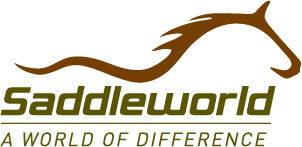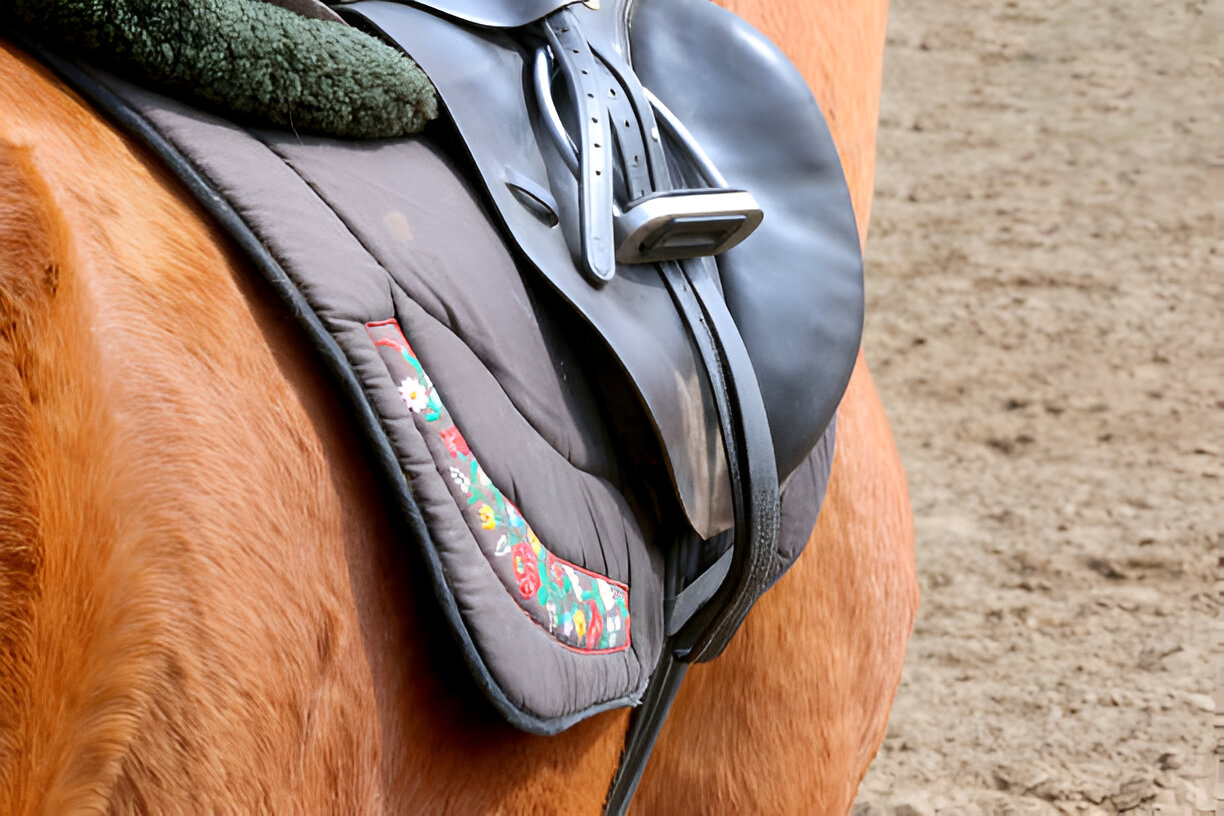
The Ultimate Guide to Impact Gel Saddle Pads: Revolutionizing Equine Comfort
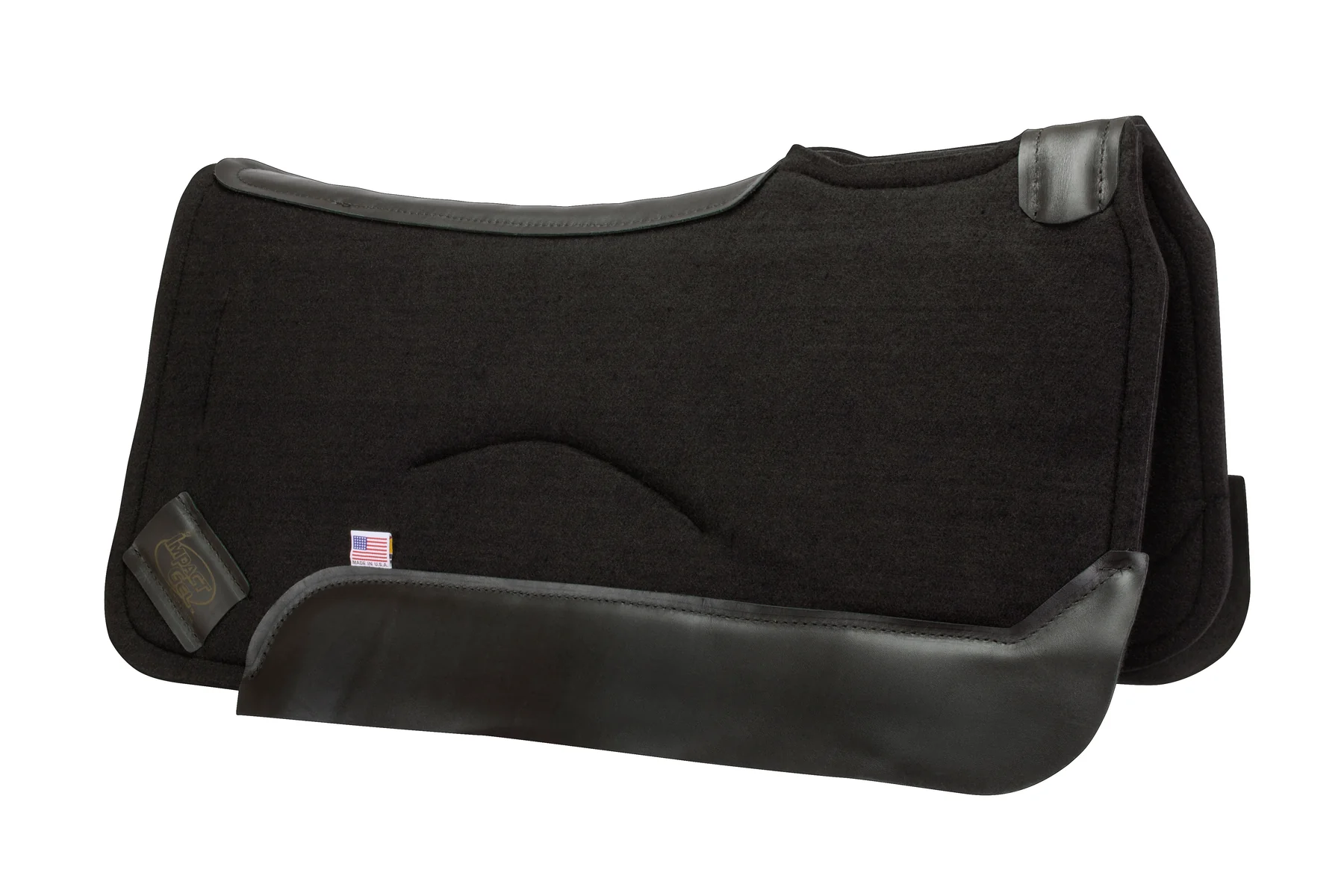
The highly popular Impact Gel Contour Classic Saddle Pad, known for its superior shock absorption
As a lifelong equestrian who’s spent countless hours in the saddle – from trail riding through rugged mountain terrain to competing in high-stakes barrel racing – I’ve experienced firsthand how crucial saddle fit and padding are for both horse and rider. When I first encountered impact gel saddle pads nearly a decade ago, I was admittedly skeptical. Could a fancy pad with some “miracle gel” really make that much difference? After years of testing dozens of saddle pads across various disciplines and conditions, I can confidently say that impact gel technology has truly revolutionized equine comfort and performance.
In this comprehensive guide, I’ll share everything I’ve learned about impact gel saddle pads – from the science behind the technology to practical advice on selection, care, and optimization. Whether you’re a weekend trail rider concerned about your horse’s back health or a serious competitor looking to enhance performance, understanding this innovative padding solution could be game-changing for your equestrian journey.
What Are Impact Gel Saddle Pads?
Impact gel saddle pads represent a significant advancement in equine equipment technology, utilizing specialized semi-solid gel inserts strategically positioned within traditional saddle pad materials. Unlike conventional pads that simply provide a buffer between saddle and horse, impact gel pads actively work to absorb and redistribute pressure, creating a more dynamic interface between horse and rider.
The core component – the gel itself – is a proprietary material developed specifically for equine applications. It remains stable across extreme temperature ranges (from -40°F to 250°F according to Impact Gel), ensuring consistent performance whether you’re riding in desert heat or winter conditions. This temperature stability sets it apart from many foam alternatives that can harden in cold weather or compress excessively in heat.
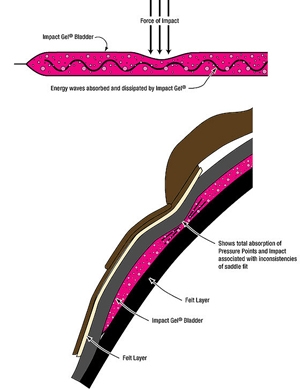
Diagram illustrating how Impact Gel technology distributes pressure
How Impact Gel Technology Works
The brilliance behind impact gel technology lies in its unique molecular structure and behavior under pressure. While traditional padding materials compress when force is applied, potentially creating pressure points, impact gel operates on a different principle entirely.
The Science of Shock Absorption
When pressure is applied to impact gel, the material’s energy-dissipating molecules respond by laterally dispersing force away from the point of impact. This creates a remarkable “ripple effect” that distributes weight and shock across a wider surface area. Think of dropping a stone in water – the impact energy travels outward in concentric circles rather than straight down.
This lateral dispersion mechanism means that instead of compression creating potential pressure points (as with foam or felt), the gel maintains more consistent contact across the horse’s back while simultaneously preventing the concentration of force in any single area. It’s this unique behavior that makes impact gel particularly effective at addressing saddle fit inconsistencies.
Strategic Placement Within Pads
Most impact gel saddle pads don’t use gel throughout the entire pad – rather, manufacturers strategically position gel inserts where they’ll provide maximum benefit. Typically, this means gel placement in areas corresponding to:
- The bars of the saddle tree (where significant weight is distributed)
- Beneath the rider’s seat bones (absorbing rider movement impact)
- Along the spine channel (protecting the sensitive spinous processes)
- At the shoulders and withers (where movement friction is greatest)
This targeted approach allows pad designers to balance the benefits of gel with other considerations like breathability, weight, and overall pad flexibility. It also means that different pad models can be optimized for specific disciplines or riding styles by adjusting gel placement patterns.
Benefits of Impact Gel Saddle Pads
For Your Horse
The primary benefits of impact gel technology directly address your horse’s comfort and physical wellbeing. After using these pads with dozens of horses over the years, I’ve observed the following advantages:
- Reduced Back Soreness: The shock-absorbing properties minimize impact forces that can cause muscle fatigue and soreness.
- Improved Saddle Fit Compensation: Gel helps bridge minor inconsistencies between saddle tree and horse’s back anatomy.
- Better Weight Distribution: Lateral force dispersion spreads rider weight more evenly across the contact area.
- Decreased Friction and Rubbing: Quality gel pads reduce the micro-movements that cause rubbing and hair loss.
- Enhanced Cooling: Many modern gel pads incorporate ventilation systems that work with the gel to improve airflow.
- Spine Protection: Properly designed gel pads provide clearance for the spinous processes while supporting surrounding tissue.
For Riders
As riders, we also benefit significantly from these innovative pads:
- Improved Stability: Reduced saddle shifting creates a more secure riding platform.
- Enhanced Feel: Many riders report better connection and feel with their horse’s movement.
- Reduced Rider Fatigue: Shock absorption works both ways, protecting the rider’s joints from concussive forces.
- Confidence in Equipment: Knowing your pad is providing optimal protection allows better focus on riding.
- Extended Saddle Longevity: By reducing friction between saddle and horse, gel pads can help preserve saddle trees and leather.

A western horse fitted with an Impact Gel saddle pad showing proper placement
Types of Impact Gel Saddle Pads
The market offers several variations of impact gel saddle pads, each designed to address specific riding disciplines, horse conformations, and rider preferences. Understanding these options will help you make an informed choice for your particular needs.
Western Impact Gel Pads
Contour Cut Pads
Contour cut pads feature a curved design that follows the natural shape of a horse’s back. The spine relief channel is typically wider at the withers and tapers toward the back. These pads excel at fitting horses with prominent withers or those with significant back contours. I’ve found them particularly effective for older horses who may have developed some muscular asymmetry.
Straight Cut Pads
Straight cut pads maintain a uniform spine channel width throughout the pad. They work well for horses with flatter backs or when using saddles with wider gullets. These tend to be slightly more versatile across multiple horses but might not provide as customized a fit for horses with distinctive toplines.
Barrel Racing/Performance Pads
Designed specifically for speed events, these pads typically feature reinforced wear leathers, extra gel in high-impact areas, and designs that maximize security during rapid direction changes. Many include advanced anti-slip technology beneath the saddle to prevent shifting during intense maneuvers.
English Impact Gel Pads
Half Pads
Half pads sit between the saddle and a regular saddle pad, providing targeted gel protection in the most critical areas. These have become extremely popular in jumping and dressage circles for their ability to enhance fit without dramatically changing the close-contact feel of English disciplines.
Full Gel Pads
Less common but available for English riders who prefer a single-pad solution, these incorporate gel technology within a complete English-cut pad. They tend to be preferred by those using production saddles rather than custom-fitted options.
Specialized Therapeutic Options
Front-Loading Pads
These pads feature additional gel in the front third to help balance saddles that tend to sit cantle-low or to accommodate horses with lower withers and shoulders that need extra clearance.
Rear-Loading Pads
Conversely, these incorporate more gel in the rear panels to support horses with dropped backs or to balance saddles that tend to be pommel-low.
Full Therapeutic Systems
Some manufacturers offer comprehensive pad systems with interchangeable gel inserts that can be positioned based on specific fit challenges or therapeutic needs, allowing for a highly customized approach to pressure distribution.
How to Choose the Right Impact Gel Saddle Pad
Selecting the optimal impact gel pad involves considering several factors related to your horse, your saddle, and your riding activities. Having helped dozens of riders make this selection, here’s my practical approach:
Assess Your Horse’s Needs
Start by evaluating your horse’s back shape and any specific issues they may have:
- Back Profile: Is your horse’s back mutton-withered, high-withered, swayed, or level?
- Muscling: Does your horse have well-developed, average, or poor topline muscling?
- Sensitivity: Has your horse shown signs of back pain or saddle sensitivity?
- Asymmetry: Are there noticeable differences between the left and right sides of your horse’s back?
- Previous Issues: Has your horse had specific problems with other pads (slipping, rubbing, sweating)?
Evaluate Your Saddle Fit
Remember that impact gel pads can help compensate for minor fit issues but are not a solution for a fundamentally ill-fitting saddle:
- Identify where your saddle makes inconsistent contact with your horse’s back
- Note if your saddle tends to sit pommel-high or cantle-high
- Check if your saddle has adequate wither clearance with your current padding
- Assess whether your saddle tends to shift during specific movements
For more details on saddle parts and proper fit, check out this excellent guide to horse saddle parts that breaks down all the essential components.
Consider Your Riding Discipline
Different activities create different pressure patterns and demands:
| Riding Discipline | Recommended Impact Gel Pad Features | Key Benefits |
|---|---|---|
| Trail Riding | Thicker gel inserts, contoured design, moisture-wicking materials | Enhanced comfort over long hours, improved stability on varied terrain |
| Barrel Racing | Reinforced edges, non-slip bottom layer, extra gel in rear panels | Saddle stability during turns, improved shock absorption on hard landings |
| Roping/Cutting | Durable materials, extra protection at withers, reinforced wear leathers | Stability during sudden stops, protection during weight shifts |
| Dressage | Thinner profile, half-pad design, wither relief cut | Maintains close contact feel while protecting pressure points |
| Jumping | Front-enhanced gel placement, secure attachment system, spinal clearance | Absorbs landing impact, prevents saddle sliding forward |
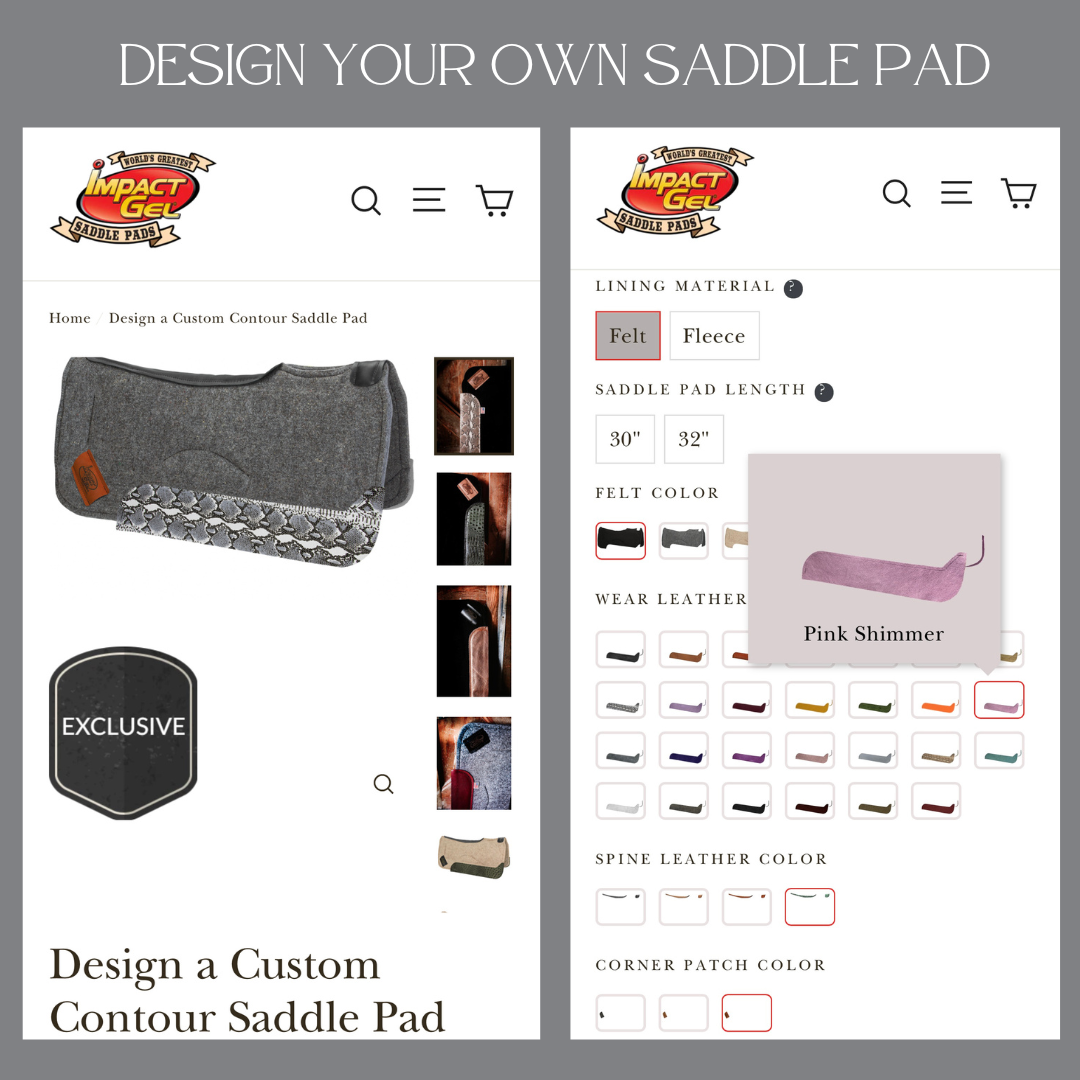
Visual demonstration of how impact gel distributes pressure compared to traditional padding
Pad Thickness Considerations
Impact gel pads come in various thickness options, typically ranging from ½” to 1½” for Western pads and thinner profiles for English applications. Thickness selection should balance protection with proper saddle position:
- Thinner pads (½”-¾”): Best for well-fitting saddles and riders wanting closer contact
- Medium pads (¾”-1″): The most versatile option, balancing protection and contact
- Thicker pads (1″-1½”): Provide maximum protection but can affect saddle fit if not accounted for
Remember that adding significant padding changes your saddle’s effective tree width. If you switch from a thin pad to a thick gel pad, you might need to adjust your saddle’s fit accordingly. According to equine biomechanics research from studies on saddle pressure distribution, just ¼” of padding can significantly alter pressure patterns on a horse’s back.
Care and Maintenance of Impact Gel Saddle Pads
Proper maintenance extends the life of your impact gel pad while ensuring it continues to perform optimally. These premium pads represent a significant investment, often costing between $200-400, so protecting that investment makes good financial sense. Here’s my maintenance routine, developed over years of using these pads in challenging conditions:
Regular Cleaning Protocol
- Daily Quick Clean: After each ride, brush off hair and debris with a stiff grooming brush. This prevents dirt buildup that can abrade both the pad and your horse’s skin.
- Weekly Deep Clean: For heavily used pads, follow these steps weekly (or bi-weekly for less frequent riders):
- Remove loose debris with a brush or vacuum
- Spray the pad with a gentle equine pad cleaner or a diluted mixture of mild soap and water
- Use a pressure washer or garden hose on low setting, working from the center outward (this follows the manufacturer’s recommendations from Impact Gel)
- Rinse thoroughly until water runs clear, ensuring all cleaning solution is removed
- Allow to air dry completely in a well-ventilated area, preferably hanging over a fence or rack to maintain shape
⚠️ Warning: Cleaning Precautions
Never machine wash impact gel saddle pads as this can damage the gel’s structure and the pad’s stitching. Avoid harsh chemicals, bleach, or strong detergents that can degrade materials and potentially leave residues that irritate your horse’s skin. Always ensure the pad is completely dry before use to prevent mold and mildew growth.
Storage Best Practices
Proper storage prevents unnecessary wear and maintains the pad’s structural integrity:
- Store flat or hung properly on a wide, supportive rack (avoid folding which can create permanent creases)
- Keep in a dry, temperature-controlled environment away from direct sunlight
- Use a breathable cover if storing long-term to prevent dust accumulation
- Never stack heavy objects on top of gel pads, as this can compress the gel unevenly
- If traveling with the pad, use a protective pad carrier to prevent damage
Regular Inspection
Develop the habit of examining your pad thoroughly at regular intervals:
- Check for signs of uneven wear that might indicate saddle fit issues
- Examine stitching for any separation or weakness
- Feel for changes in gel consistency or distribution
- Look for compressed areas that aren’t rebounding properly
- Inspect for mold, mildew, or unusual odors that might indicate improper drying

Proper maintenance and cleaning extends the life of your saddle pad investment
Common Misconceptions About Gel Saddle Pads
As with any innovative technology, impact gel pads are surrounded by certain myths and misconceptions. Having worked extensively with these products, I’d like to address some of the most common ones:
Myth: Gel Pads Can Fix Any Saddle Fit Issue
While impact gel technology is remarkably effective at compensating for minor fit inconsistencies, it is not a magic solution for fundamentally ill-fitting saddles. A pad cannot correct a tree that’s too narrow, pinching the withers, or a saddle that bridges significantly (making contact only at the front and back). Think of gel pads as enhancers of adequate fit, not replacements for proper saddle fitting.
Myth: Gel Pads Are Too Hot for Summer Use
Early generations of gel pads did sometimes trap heat, but modern designs incorporate ventilation features, heat-wicking materials, and breathable fabrics specifically engineered to address this concern. Many impact gel users (myself included) find that the pressure-relieving benefits outweigh any potential heat increase, particularly when choosing models designed with ventilation in mind.
Myth: All Gel Pads Are Created Equal
There’s significant variation in quality between different gel pad manufacturers. The proprietary gel formulations, construction methods, materials, and design approaches differ substantially. Less expensive “gel-like” pads often use simple silicone or lower-grade materials that don’t offer the same molecular behavior as true impact gel. This is definitely a category where research and investment in quality pays dividends.
Myth: Gel Pads Never Need Replacement
While quality impact gel maintains its properties longer than many foam alternatives, it does not last forever. With regular use, the gel will eventually begin to lose some of its rebound capabilities. Most quality gel pads should last 3-5 years of regular use with proper care, though I’ve seen some that perform well for longer periods.
Real-World Application Tips
Over years of personal experience and working with numerous riders across disciplines, I’ve developed some practical tips for getting the most from impact gel saddle pads:
Optimizing Performance
- Break-in Period: Allow 5-10 rides for new gel pads to fully conform to your horse’s shape and your saddle’s contours.
- Saddle Re-evaluation: After switching to a gel pad, have your saddle fit re-checked as the additional padding may change how it sits.
- Seasonal Adjustments: Your horse’s back shape changes throughout the year with conditioning and weight fluctuations. What works perfectly in summer may need adjustment in winter.
- Layering Approach: Some riders successfully use a thin, natural-fiber pad directly against the horse with a gel pad between this base layer and the saddle.
- Monitor Performance: Keep a riding journal noting how your horse moves with different pad configurations to identify optimal combinations.
When to Upgrade or Replace
Know the signs that indicate your gel pad may be ready for retirement:
- Gel no longer rebounds quickly when compressed
- Visual compression lines remain visible after use
- Horse shows signs of increased back discomfort
- Pad begins to slip or move during rides despite proper positioning
- Materials show significant wear, thinning, or separation
Frequently Asked Questions
For most riders, particularly those spending significant time in the saddle or working with horses that have back sensitivity issues, the investment delivers substantial returns in horse comfort, performance, and saddle longevity. When you consider that a quality impact gel pad can last 3-5 years with proper care (compared to replacing traditional pads annually), the cost becomes more reasonable. As someone who’s treated horses with back issues resulting from inadequate padding, I can attest that prevention through proper equipment is far less expensive than veterinary treatment and lost riding time.
With proper care and maintenance, quality impact gel pads typically last 3-5 years of regular use. Some riders report even longer lifespans, while others in very demanding disciplines (like daily roping or barrel racing) might see shorter usable lives. The key indicators that gel is nearing the end of its effective life include slow rebound after compression, visible permanent compression lines, and decreased shock absorption performance.
While not a treatment or cure, impact gel pads can be helpful supplementary support for horses with diagnosed back conditions like kissing spine, when used under veterinary guidance. The pressure distribution and shock absorption properties can reduce painful impacts during riding. However, always work with your veterinarian and equine bodywork specialist when dealing with diagnosed back issues – the pad is just one component of a comprehensive management approach.
Absolutely. While more commonly associated with Western riding, impact gel technology has been successfully adapted for English disciplines. Half-pads with gel inserts have become particularly popular in jumping and dressage circles, offering the pressure-distributing benefits while maintaining the close-contact feel essential to these disciplines. Look for gel pads specifically designed for English saddles rather than trying to adapt Western versions.
An impact gel pad can help distribute pressure more evenly with minor fit issues but cannot correct a fundamentally too-narrow saddle. In fact, adding padding to a too-narrow saddle can sometimes exacerbate the problem by forcing the tree points even more tightly against the horse’s shoulders. For significant fit issues, consult with a professional saddle fitter before relying on padding solutions.
Safety Warnings and Considerations
⚠️ Not a Substitute for Proper Saddle Fit
Impact gel technology can enhance comfort and compensate for minor fit inconsistencies but should never be used to make a fundamentally ill-fitting saddle “work.” Continuing to ride in a poorly fitted saddle, even with premium padding, can cause lasting damage to your horse’s back muscles, nerves, and skeletal structure.
⚠️ Watch for Signs of Discomfort
Even with the best padding, always monitor your horse for signs of back pain or discomfort: resistance to saddling, hollowing the back when mounted, reluctance to move freely, tail swishing during work, or behavior changes under saddle. Addressing these signs promptly can prevent development of serious issues.
⚠️ Proper Placement is Critical
Incorrect positioning of gel pads can negate their benefits and potentially create new pressure points. Always ensure the pad is centered properly, with the spine channel directly over your horse’s spine and any contour features aligned correctly with your horse’s anatomy.
⚠️ Check for Gel Integrity
Damaged gel inserts can create unpredictable pressure patterns. Regularly inspect your pad’s gel components for signs of leaking, hardening, or significant deformation that doesn’t recover. If the gel seems compromised, discontinue use immediately.
Conclusion: Making an Informed Decision
After exploring the science, benefits, and practical aspects of impact gel saddle pads, you’re now equipped to make an informed decision about whether this technology is right for your equine partner. My journey with these innovative pads has convinced me of their value – not as a miracle solution, but as a thoughtfully engineered tool that, when properly selected and used, can significantly enhance both horse comfort and rider performance.
What impresses me most about quality impact gel padding is not just the immediate comfort it provides but the long-term protective benefits. By minimizing damaging pressure points and absorbing impact forces that would otherwise transfer directly to your horse’s musculoskeletal system, these pads represent a genuine investment in your horse’s longevity and well-being.
Whether you’re addressing specific back sensitivity issues, compensating for seasonal changes in your horse’s topline, or simply aiming to provide the best possible experience for both yourself and your equine companion, impact gel technology offers compelling advantages worth serious consideration.
As with any equipment choice, take time to evaluate your specific needs, consult with professionals when necessary, and prioritize solutions that enhance the partnership between you and your horse. After all, that partnership is what makes every ride worthwhile.
© 2025 Saddle World Caboolture. This comprehensive guide to impact gel saddle pads is provided for informational purposes only and should not replace professional advice for your specific equine needs.
